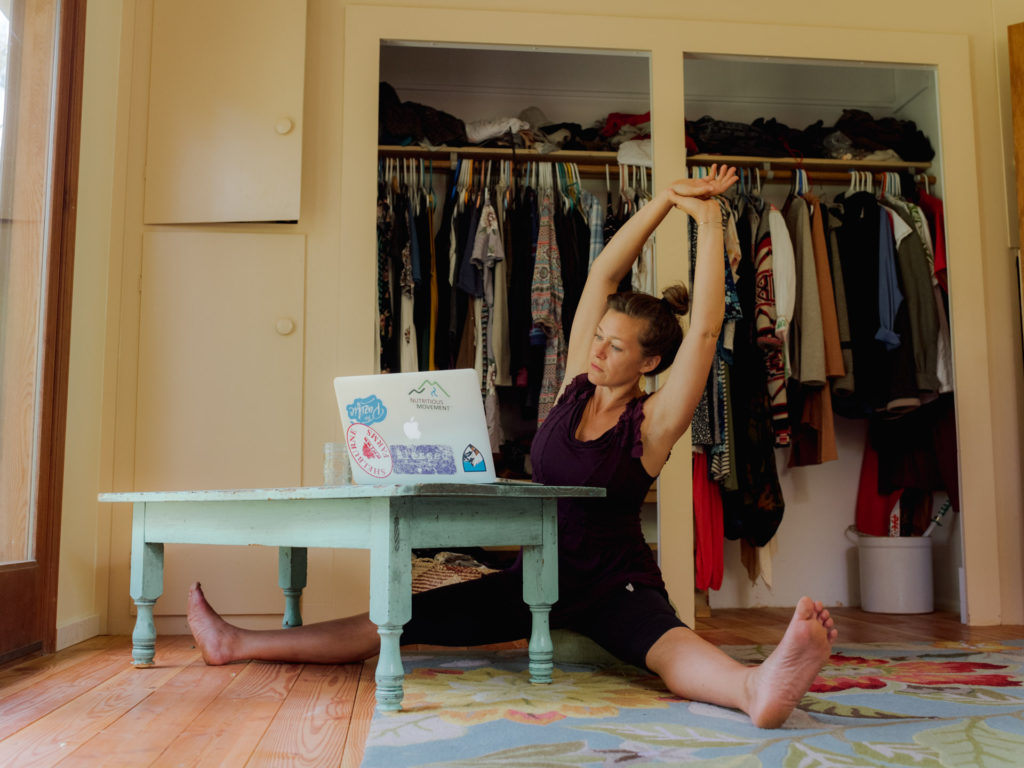
A simple way to start moving your body more is to swap your sedentary seat for “active sitting.” How much of your body’s work are you giving to the chair? If the back of the chair disappeared, what would happen? Would you collapse backwards? If yes, then the chair-back is doing the work of your core musculature. And obviously, if the bottom of a chair dropped out we’d fall straight down because the chair is also doing the work of the legs.
To make sitting more active, choose a position that uses more of your own body to support you. Here’s an easy place to start: When chair-time is necessary, just scoot forward and away from the back of a chair to use more of your torso. Even if you’re sitting there you don’t have to just sit there.
To get more parts of your body active, opt to sit on the floor, a stacked pillow or two, or an ottoman or crate (anything lower than your current seat). Getting to and from the floor or lower seat uses your leg-parts more and once you’re down there, there are different leg-position options that each move you differently. Cycle through a few different leg positions to challenge your joints and surrounding tissue: sit with your legs in a V, cross-legged, or in any way that challenges your stiff parts.

Research has shown that a squat is the most active rest position, but even if that’s not available, the options above will get you moving more.
Want some ideas of all the ways there are to sit? Check out our poster (or print-at-home graphic) that features 53 ways to take a seat! (You can also find this chart on page 106 of Move Your DNA).

Speaking of the poster, this was a favorite exchange about it that highlights some of what’s discussed above as well as how to think about movement in a more nuanced way.
Hi Katy,
I love this poster, but I’ve been asked a few times, “aren’t the six positions in the right top row just sitting positions?” I have been lost as to what to tell them about chair-type sitting positions in a chair-free posture poster. - Mover
Hi Mover,
Except for the first four standing-at-rest positions, the poster is showing all sitting positions, right? You could totally adapt the leg positions featured in the top right row while sitting in a chair, but also when sitting on rocks, logs, or other “perches.” Same with the bottom five—those are “arm-resting” options that could be used standing, sitting in a chair or wheelchair, or sitting on the ground. - KB
Thanks for the reply Katy!
Yeah, it makes sense if you consider logs, rocks, or other perches, but from most people’s perspectives, those align with chairs, and this is supposed to be “chair-free”. I was just at a loss of what to tell people when they asked about those specific chair positions on the chair-free poster above my ground-living dining table at my furniture-free home. - Mover

Hello again, Mover.
This has to do with how they hold the concept of “chair” equal to “seat” in their minds. For example, I'd wager most people use the back of their chair as much as the "seat" part. You could tell them a seat isn't necessarily a chair and those six positions in question are examples of how to position your body so that when perching on a variety of seats, your torso works more to hold itself up and the leg-loads differ.
The work depicted here is by Gordon Hewes, an anthropologist who went around capturing how many different cultures take rest. None of these images are of chairs, but you can see the variety of how different people "took a seat or rest" in their environment. - KB
Ah, right!
I guess that all makes sense when you consider that sitting on something like a log in nature has no back rest and therefore requires the same postural regulations and adaptations internally as would sitting cross legged on the ground. - Mover
Find the ‘Think Outside the Chair’ Poster and ‘Think Outside the Chair’ Printout available in our store.
Sitting differently is just one of my three easy ways to move your DNA. Find the other two here.